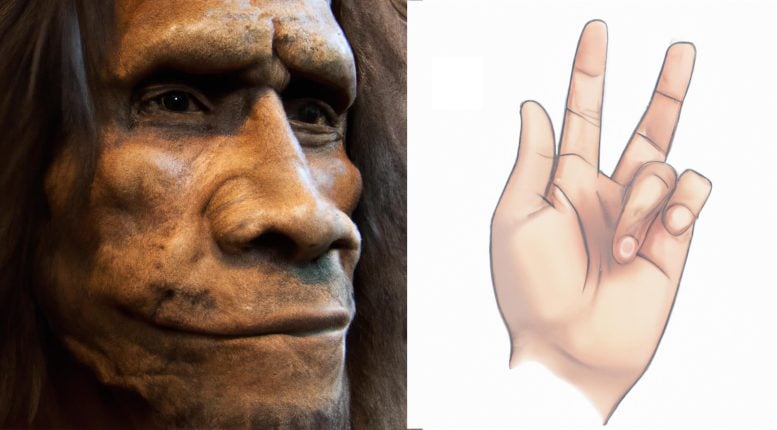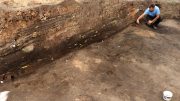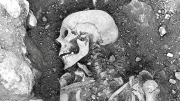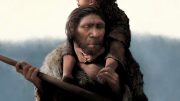
An illustration of a Neanderthal and a sketch of ring finger locked in a bent position as seen in Dupuytren’s disease, colloquially known as the “Viking disease.” New research finds that the genetic origins of “Viking disease,” a condition that affects older Northern European men, can be traced back to Neanderthals. Credit: Hugo Zeberg
Many men in northern Europe over the age of 60 suffer from the so-called Viking disease, which means that the fingers lock in a bent position. Now researchers at Karolinska Institutet, together with colleagues, have used data from over 7,000 affected individuals to look for genetic risk factors for the disease. The findings, which have been published in Molecular Biology and Evolution, show that three of the strongest risk factors are inherited from Neanderthals.
Up to 30 percent of men in northern Europe over 60 suffer from a condition called Dupuytren’s contracture. The condition is sometimes called the Viking disease because it mainly affects individuals with northern European ancestry. The disease is significantly more common in men than women and usually begins as a lump in the palm of the hand that grows and causes one or more fingers to lock in a bent position. The condition is usually not painful, but the nodules may sometimes be tender to pressure.

Hugo Zeberg, assistant professor at the Department of Physiology and Pharmacology, Karolinska Institutet. Credit: Alexander Donka
The researchers in the study, led by Hugo Zeberg from Karolinska Institutet and Svante Pääbo from Max Planck Institute for Evolutionary Anthropology, set out to investigate whether genetic variants inherited from Neanderthals are involved in the disease.
Neanderthals lived in Europe and western Asia until about 40,000 years ago, when they were replaced by modern humans. However before Neanderthals disappeared, they mixed with modern humans. As a result, between one and two percent of the genomes of people with roots outside of Africa come from Neanderthals.
“Since Dupuytren’s contracture is rarely seen in individuals of African descent, we wondered whether gene variants from Neanderthals can partly explain why people outside of Africa are affected,” says Hugo Zeberg, assistant professor at the Department of Physiology and Pharmacology, Karolinska Institutet.
The researchers used data from three large clinical cohorts in the US, UK, and Finland, which allowed them to compare the genomes of 7,871 sufferers and 645,880 healthy controls. They identified 61 genetic risk factors for Dupuytren’s contracture. The researchers found that three of these were inherited from Neanderthals, and these included the second and third most important risk factors.
The study is further evidence that the intermingling between Neanderthals and our ancestors has important consequences for the prevalence of some diseases, particularly among certain groups.
“This is a case where the meeting with Neanderthals has affected who suffers from illness, although we should not exaggerate the connection between Neanderthals and Vikings,” says Hugo Zeberg.
Reference: “Major Genetic Risk Factors for Dupuytren’s Disease Are Inherited From Neandertals” by Richard Ågren, Snehal Patil, Xiang Zhou, FinnGen, Kristoffer Sahlholm, Svante Pääbo and Hugo Zeberg, 14 June 2023, Molecular Biology and Evolution.
DOI: 10.1093/molbev/msad130
The study was financed by The Swedish Research Council, The Swedish Brain Foundation, The Erik Philip-Sörensen Foundation, Petrus och Augusta Hedlunds Stiftelse, and Emil och Wera Cornells Stiftelse.









Why do you keep blocking the end of the article with a button that says “show expanded article”? The only reason I can’t see it is because of the stupid button you added recently. It’s like you’ve decided you don’t actually want people to read your articles anymore.
Agreed. There must be some purpose to this new PITA. Is it the beginning of a possible paywall?
I’m 2.8% Neanderthal per 23andme and I have a mild case of Dupuytren’s contracture. In my case, I do not have any bent/locked fingers. What I do have is some hard nodules on my palms that I thought were calluses for a long time.
There are a number of possible treatments and this article should have covered them.
I am 80yrs old i sufferd dupetrons many years ago all the male in my ancestry lived ripe old ages going back to 1735 one lived till he was 91 is this thanks to vkings